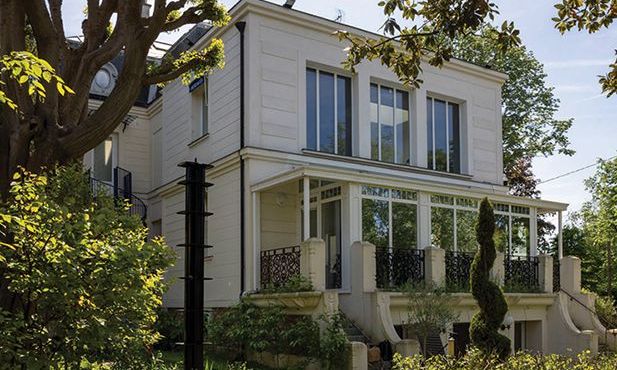Looking to eliminate cultural ignorance and to share knowledge: the Musée d’Art et de Culture Soufis MTO
© Jean-Yves Lacôte
From the legendary Persian poet Rumi to Iran’s most famous living sculptor, Parviz Tanavoli, artists have drawn on the teachings of Sufism for centuries. This month, the first ever museum devoted to Sufi art and culture is set to open in the Paris suburb of Chatou.
Sufism can generally be understood as the mystical aspect, or dimension, of Islam. It is a spiritual path that emphasises achieving intimacy with God, facilitated through the guidance of a master (a pir or sheikh), as well as ascetic practices and meditative acts such as prayer and chanting. Music, writing and works of art have been critical to its development—in rituals, as symbols, and as a means of transmitting ideas and experiences across generations.
The Musée d’Art et de Culture Soufis MTO is located in a restored 19th-century mansion on the Seine, opposite the Île des Impressionistes. It brings together hundreds of objects from the collections of the Maktab Tarighat Oveyssi (MTO) Shahmaghsoudi School of Islamic Sufism, a non-profit organisation with centres across six continents which initiated the museum. Two affiliated organisations—the American Friends and the Canadian Friends of Sufi Arts, Culture and Knowledge—provided the museum’s primary startup funding. The museum’s director, Alexandra Baudelot, says the long-term plan is “to develop an economic model that is based both on public and private funding”.
A kashkūl , made from featuring portraits and names of the Five Infallibles
Collection of the Musée d’Art et de Culture Soufis MTOTM. Photo: Jean-Yves Lacot
Highlights from the collection include a selection of kashkūls, richly decorated bowls that Baudelot says represent the “renunciation of material ties and a readiness to receive divine knowledge”. Also on display is a 20th-century khirqa, a purple and yellow velvet cloak with gold embroidery presented to the current MTO master in a ceremony. “When a master gives his disciple a cloak, it means that he is now the master,” Baudelot says.
A key part of the museum’s mission is to show the “universality” of Sufism, Baudelot says, and its relevance to today’s issues. The museum will run a programme placing contemporary art in dialogue with the collection, beginning with an exhibition featuring work by seven contemporary artists.
Among them is Morocco-based Younès Rahmoun. He has been inspired by Sufi teachings since studying art in the 1990s, when his interest in Zen Buddhism led him to the work of Rumi and the Andalusian Arab philosopher-mystic Ibn Arabi. Numbers, repetition and light are important subjects both in Sufism and the artist’s practice.
Rahmoun presents four works in Paris, including the new Markib-Habba (Seed-Boat), whose geometric metal structures reference a boat, a symbol, he says, of “an inner journey”, as well as a prism, representing a person in meditation, with a sphere in the middle. A second work, Manzil-Tayf (House-Spectrum) (2021), is a grouping of seven transparent resin houses, each a different hue. The houses represent a “refuge”, Rahmoun says, where a person “can be in harmony with themselves”.
Younes Rahmoun, Manzil-Tayf (House-Spectrum) (2021)
© Younes Rahmoun. Courtesy of Musée d’Art et de Culture Soufis MTO™
Another exhibitor is Pinaree Sanpitak, an artist based inBangkok who is known for addressing topics such as motherhood and the female body. Her recurring “breast stupa” motif, for example, references both women’s anatomy and a type of Buddhist commemorative monument.
Sanpitak says she was drawn to participating at the MTO museum because it offers “an open-minded spirituality, involving women in a lot of positive ways”. She is presenting three new paintings that respond to the kashkuls.
“They have a lot of symbolic aspects that intrigued me,” she says. “Sufis carry them around, but they don’t put anything in them. They are a place for receiving and giving, and that connects with my practice.” Her canvases feature vessel-like or natural shapes surrounded by a rich red, carrying their own sense of open-ended spirituality.
The site also has an archival research library and a Persian garden. Baudelot says the plants are deeply connected to Sufism. “Many are present in Sufi poetry, literature and medical treatises.”
Pinaree Sanpitak, The Red Cloud and The Offering Vessel (2024)
© Pinaree Sanpitak. Courtesy of Musée d’Art et de Culture Soufis MTO™
The museum opens at a challenging moment for many in France’s Muslim community, one of the largest in Europe, after a surge of support for the far-right Rassemblement National party at the recent parliamentary elections. The RN’s president, Jordan Bardella, has railed against the “Islamisation” of his neighbourhood and says the RN will look to ban various types of veils if in power.
Baudelot thinks such developments make the museum especially valuable. “These problems are related to not knowing, so it’s very important to create places where we are able to speak about different cultures and share knowledge,” she says. “I think it’s more important than ever to have this kind of project because it really links cultures together and can create some bridges.”

